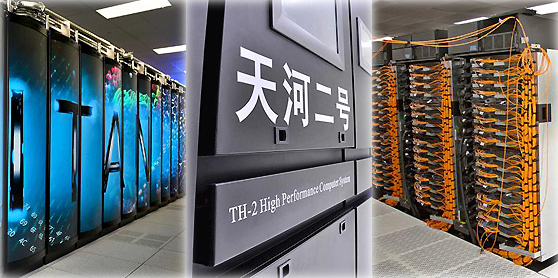Top 10 supercomputers in the world 2013
- By Xu Lin
 0 Comment(s)
0 Comment(s) Print
Print E-mail China.org.cn, June 21, 2013
E-mail China.org.cn, June 21, 2013
Tianhe-2, or Milky Way-2, a supercomputer developed by China's National University of Defense Technology, was ranked the world's fastest on a recent list of the top 500 supercomputers.
This world's new No.1 system boasts a performance of 33.86 petaflop/s on the Linpack benchmark. That is to say, the running of Tianhe-2 for one hour is equivalent to the computational works of 1.3 billion people working simultaneously on their gadgets for 1,000 years.
Tianhe-2, which took 280 researchers more than two years to complete, will be used at the National Supercomputer Center in Guangzhou for biomedicine and the development of new materials.
Besides being the world's fastest supercomputer, Tianhe-2 is also one of the most environmentally friendly ones.
The ranking is a return to the top for Chinese supercomputers. Tianhe-2's predecessor, Tianhe-1, took the number one position in November 2010. Chi Xuebin, the director of the Supercomputing Center of the Chinese Academy of Sciences, said that the performance of Chinese supercomputers is 5,000 times better than it was ten years ago. American supercomputers, by contrast, perform only 500 times better, he said.
An American supercomputer called Titan, used by U.S. Department of Energy's Oak Ridge National Laboratory, was ranked the second fastest system in the world. A different Department of Energy supercomputer, called Sequoia, ranked third.
The Top 500 list is compiled biannually by the International Supercomputing Conference. The 41st edition of the list was announced June 17 in Leizpig, Germany. The top ten fastest supercomputers are listed below.
Tianhe-1A (MilkyWay-1A)(天河一號)
Country: China
Site: National Supercomputing Center in Tianjin
Manufacturer: NUDT
Cores: 186,368
Linpack Performance (Rmax): 2,566.0 TFlop/s
Theoretical Peak (Rpeak): 4,701.0 TFlop/s
Power: 4,040.00 kW
Memory: 229,376 GB
Interconnect: Proprietary
Operating System: Linux
Compiler: ICC
MPI: MPICH2 with a custom GLEX channel
Go to Forum >>0 Comment(s)







